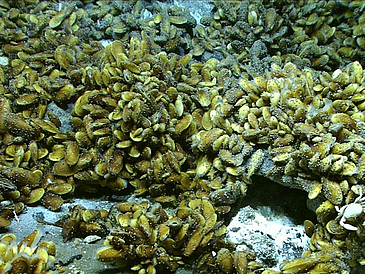Worldwide the search is on for environmentally friendly ways to meet society’s growing demands for energy. Hydrogen-powered fuel cells present a highly promising approach to solving the problem. While scientists have been going to great lengths and conducting exhaustive research in this area, mother nature long ago created its own answer in the form of living “fuel cells”. Whilst on research expeditions to investigate hot springs on the ocean floor, researchers at the Max Planck Institute of Marine Microbiology and their colleagues from the MARUM Excellence Cluster at the University of Bremen discovered mussels which have their own hydrogen-powered fuel cells “on board” – in the form of symbiotic bacteria. In the current issue of “Nature”, the researchers describe what they now believe to be a widespread capability of populations living around springs on the ocean floor to use hydrogen as a source of energy.
Hot springs on the ocean bed occur at the places where the Earth’s plates overlap; where magma rises to the upper crust of the Earth and comes into contact with seawater. At a temperature of around 400°C, the heated seawater dissolves the minerals in the Earth’s crust which then escapes through so-called “black smokers”. Hydrogen sulphide, ammonium, methane, iron and hydrogen are released into the sea. Organisms take their energy to build up carbohydrates from the oxidation of these inorganic compounds. As the sun’s rays cannot penetrate down into the depths of the ocean, they must take their energy from chemical reactions. By way of analogy with photosynthesis, one therefore speaks of chemosynthesis.
Chemosynthetic microorganisms therefore form the basis of life for the peculiar populations living around the hot springs on the ocean floor. For many until recently completely unknown species of worm, molluscs and anthropods are only able to survive there because they have entered into symbiotic relationships with bacteria and thus operate their own little power stations, so to say. Until now, though, only two sources were known from which the respective symbiotic microorganisms could draw their energy: Hydrogen sulphide and methane. “Now we have discovered a third source”, says the leader of the research project, Nicole Dubilier, from the Max Planck Institute of Marine Microbiology in Bremen.
More information under www.marum.de

